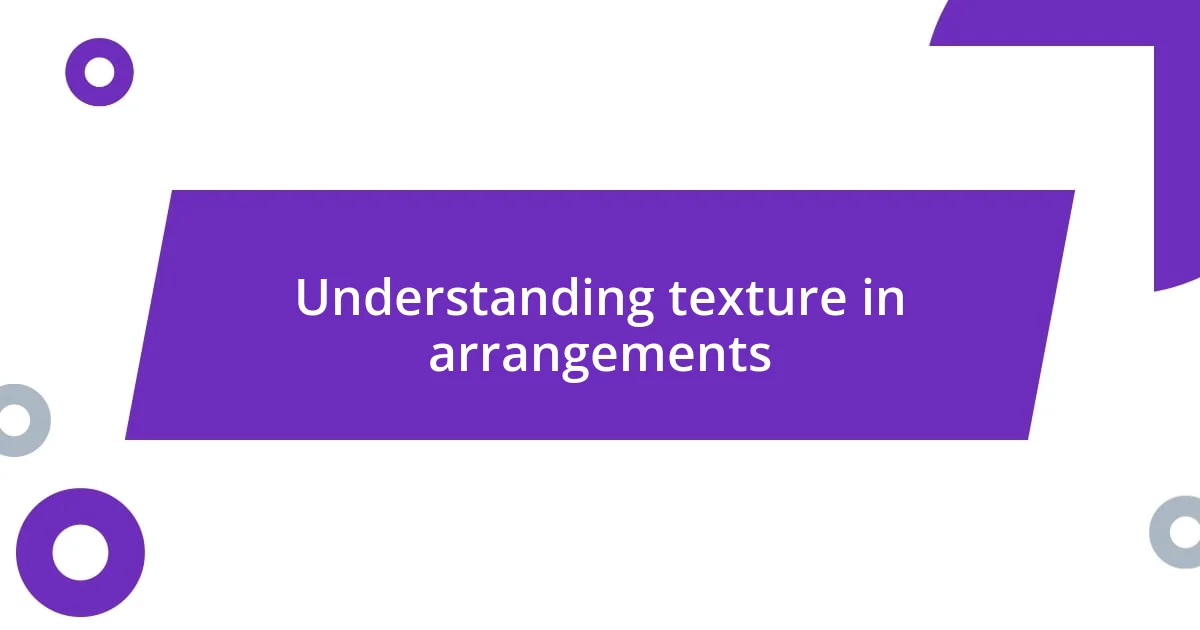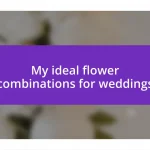Key takeaways:
- Texture enhances sensory experiences, evoking emotions and inviting touch, ultimately transforming arrangements into engaging visual and tactile experiences.
- Balancing and layering different textures—such as soft with hard or natural with artificial—creates depth, visual interest, and emotional resonance in design.
- Practical techniques like utilizing negative space and incorporating accents can elevate the impact of arrangements, fostering interaction and enhancing overall aesthetic appeal.

Understanding texture in arrangements
Texture in arrangements goes beyond mere visual appeal; it creates a sensory experience that can evoke emotions and set moods. I vividly remember a time when I combined smooth pebbles with rough bark in a decorative bowl. The contrast not only caught the eye but also sparked a curiosity that drew my guests in—everyone wanted to touch and explore the different surfaces.
In my experience, texture also plays a vital role in balancing an arrangement. Take, for instance, a bouquet filled with delicate feathers alongside sturdy succulents. The varying textures not only complement each other but also tell a story of contrast and harmony. Have you ever felt how an arrangement can shift your perspective just by the way it feels? That’s the magic of texture—it can transform a simple setup into something extraordinary.
When I think about texture, I often contemplate how it invites touch and interaction. I recall one particular event where I used a mix of glossy leaves and matte blooms. The guests were not only captivated by the colors but found themselves reaching out to feel the different finishes. Isn’t it fascinating how something as simple as texture can create connections and elevate the overall arrangement?

Types of textures to consider
When it comes to integrating texture into arrangements, there are various types to consider. Natural textures like wood, stone, and foliage evoke a sense of earthiness and organic beauty. I remember a moment at a friend’s wedding when the rustic wooden elements paired with vibrant blooms created a captivating blend that was both inviting and warm. It reminded me how these raw materials can stir feelings of connection to nature.
On the other hand, artificial textures often bring modernity and a sleek finish to arrangements. Think glossy ceramics or metallic accents. I experimented with shiny vases and rough, unpolished stones for a contemporary centerpiece once, and it was a hit! The juxtaposition not only highlighted each material’s uniqueness but also spurred a conversation about the evolution of design aesthetics. Isn’t it interesting how the combination of different textures can also reflect a blend of tradition and innovation?
Lastly, consider incorporating textures that represent contrasting feelings. For instance, soft fabrics can evoke comfort, while harder surfaces may convey strength. During a recent gallery event, I used plush velvet and sharp glass in an arrangement that sparked deep conversations about vulnerability and resilience. That experience solidified my belief that textures do more than please the eye—they narrate a story that resonates with people at various emotional levels.
| Type of Texture | Description |
|---|---|
| Natural | Elements like wood, stone, and foliage that reflect organic beauty and earthiness. |
| Artificial | Materials such as ceramics and metals that provide a modern, sleek aesthetic. |
| Contrasting | Textures that combine soft and hard elements, illustrating complex emotional themes. |

Choosing materials for texture
Choosing the right materials for texture is crucial in crafting an engaging arrangement. I’ve often found that the materials I choose can profoundly affect the experience of an arrangement. For example, in one of my latest designs, I incorporated woven rattan alongside glossy glass. The contrast struck me as particularly important, as it invited interaction; guests were intrigued to compare the warmth of the woven surface with the coolness of the glass.
Here are some tips for selecting materials that enhance texture:
- Consider Contrast: Mixing soft and hard materials can create a dynamic feel. Think silk paired with metal or smooth ceramic with rugged stone.
- Think About the Sensory Experience: Choose materials that feel interesting to the touch, like knobby pinecones or silky fabrics.
- Embrace the Unexpected: I once paired dried lavender with metallic wire, and the guests were captivated by how the delicate flowers contrasted sharply with the industrial element.
- Reflect Personal Style: Incorporating materials that resonate with your personal aesthetic can add a layer of authenticity, making the arrangement feel truly yours.
The decision-making process around material selection is an expression of self, and I absolutely love how textures can narrate a story of their own. Each choice can breathe life into the creation, highlighting not just beauty, but the senses and stories behind each component.

Layering textures effectively
Layering textures effectively is all about creating depth and dimension in your arrangements. I remember a specific moment when I added a rough-hewn wooden base to a sleek glass vase. The visual contrast was striking, and it invited people to touch both surfaces. Isn’t it fascinating how something as simple as texture can transform the entire experience?
When it comes to layering, think about how different textures respond to light and shadow. I’ve used matte fabrics alongside shiny elements, noticing how the interplay creates a delicious contrast. It’s like a dance; each texture plays its part, enhancing the overall composition. This layered interaction not only captivates the eye but also evokes emotions that are unique to each viewer.
Don’t be afraid to experiment with the unexpected! I once layered a soft faux fur with sharp metal edges in a holiday display. The reaction was incredible; guests were drawn in, their eyes lighting up with curiosity. This taught me that layering textures isn’t just about aesthetics; it’s a powerful way to tell a story, one that invites engagement and conversation. Have you ever experienced that fusion of elements that left you feeling connected to an arrangement? It’s moments like those that remind me of the magic in thoughtful design.

Balancing textures in design
Balancing textures in design is essential for creating harmony in your arrangements. I vividly recall a time when I arranged a centerpiece with soft, fluffy feathers nestled next to sharp-edged stones. The juxtaposition not only caught the eye but also created a delightful interplay that made everyone stop and admire. It’s incredible how even the slightest variation in texture can evoke a feeling of balance—or sometimes imbalance—that stirs the emotions of those who engage with it.
I’ve learned that the key to balance lies in proportion. When I worked on a large display, I made sure to distribute heavier, coarse textures evenly among lighter, airy elements. For instance, pairing a bulky crochet piece with delicate lace wasn’t merely about aesthetics; it was about encouraging viewers to explore the arrangement from different angles. Have you ever noticed how the placement of textures can lead your eyes across a landscape of shapes and feelings? That’s the magic of thoughtful balancing.
Sometimes, the beauty of balance is in its subtlety. I once created an event spread with muted, velvety fabrics juxtaposed with clear acrylic elements. At first glance, it seemed understated, but as guests touched and felt the pieces, the contrast revealed depth and richness. It’s moments like these that bring joy to design; gently balancing textures can not only elevate the visual appeal but also deeply connect people to the experience. How do you feel when you discover a balance that resonates? It’s that spark of realization that keeps me inspired.

Adding depth with texture
When I think about adding depth with texture, I often reflect on a vibrant floral arrangement I created for a friend’s wedding. I layered velvety roses with spiky thistles and soft moss. The visual tension drew the eye in, prompting guests to lean closer and truly appreciate the details. Isn’t it amazing how the mix of textures can transform a simple bouquet into a stunning centerpiece that invites exploration?
In my experience, contrast is the heartbeat of depth. I remember incorporating glossy ceramic pots with rough, weathered stones in a garden display. The glossy surfaces caught the sunlight beautifully while the stones offered a grounding effect. This interplay not only created visual intrigue but also encouraged a tactile interaction that deepened the viewer’s connection to the arrangement. Have you ever run your fingers over a surface that made you pause and reflect? Texture has that power.
Recently, while preparing for a family gathering, I played with layering transparent glass terrariums over a bed of coarse sand. The transparency added an element of surprise, as the layers of texture revealed hidden treasures. It’s thrilling when depth invites curiosity, making others want to touch and experience the arrangement firsthand. How does texture play into your designs? I find that these creative choices can lead to unforgettable moments of connection and inspiration.

Practical tips for incorporating texture
When it comes to incorporating texture, I can’t stress enough the importance of layering. I once played with a combination of crinkled paper, smooth silk, and rough hemp in a scrapbook for a class project. The varying textures not only popped visually but also invited people to touch and explore. Doesn’t it feel rewarding when an arrangement encourages interaction?
Another practical tip I’ve learned is about utilizing negative space effectively. I remember a tablescape where I featured a beautiful quilted runner alongside a simple glass vase filled with pebbles. The empty spaces allowed the textures to breathe, enhancing the overall impact. Have you noticed how too much detail can sometimes overwhelm the senses? A bit of breathing room can create a sense of harmony.
Don’t underestimate the power of accents! A small, textured element can transform an entire arrangement. For example, I added a few hand-painted clay pots filled with herbs next to a sleek marble countertop in my kitchen, and the result was delightful. The contrast ignited conversations about texture and design. Isn’t it incredible how a few thoughtful accents can spark interest and elevate ordinary spaces?














